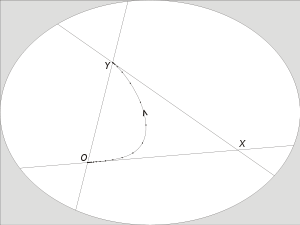W-curve
In geometry, a W-curve is a curve in projective n-space that is invariant under a 1-parameter group of projective transformations. W-curves were first investigated by Felix Klein and Sophus Lie in 1871, who also named them. W-curves in the real projective plane can be constructed with straightedge alone. Many well-known curves are W-curves, among them conics, logarithmic spirals, powers (like y = x3), logarithms and the helix, but not e.g. the sine. W-curves occur widely in the realm of plants.

Name
The 'W' stands for the German 'Wurf' – a throw – which in this context refers to a series of four points on a line. A 1-dimensional W-curve (read: the motion of a point on a projective line) is determined by such a series.
The German "W-Kurve" sounds almost exactly like "Weg-Kurve" and the last can be translated by "path curve". That is why in the English literature one often finds "path curve" or "pathcurve".
See also
Further reading
- Felix Klein and Sophus Lie: Ueber diejenigen ebenen Curven... in Mathematische Annalen, Band 4, 1871; online available at the University of Goettingen
- For an introduction on W-curves and how to draw them, see Lawrence Edwards Projective Geometry, Floris Books 2003, ISBN 0-86315-393-3
- On the occurrence of W-curves in nature see Lawrence Edwards The vortex of life, Floris Books 1993, ISBN 0-86315-148-5
- For an algebraic classification of 2- and 3-dimensional W-curves see Classification of pathcurves
- Georg Scheffers (1903) "Besondere transzendente Kurven", Klein's encyclopedia Band 3–3.